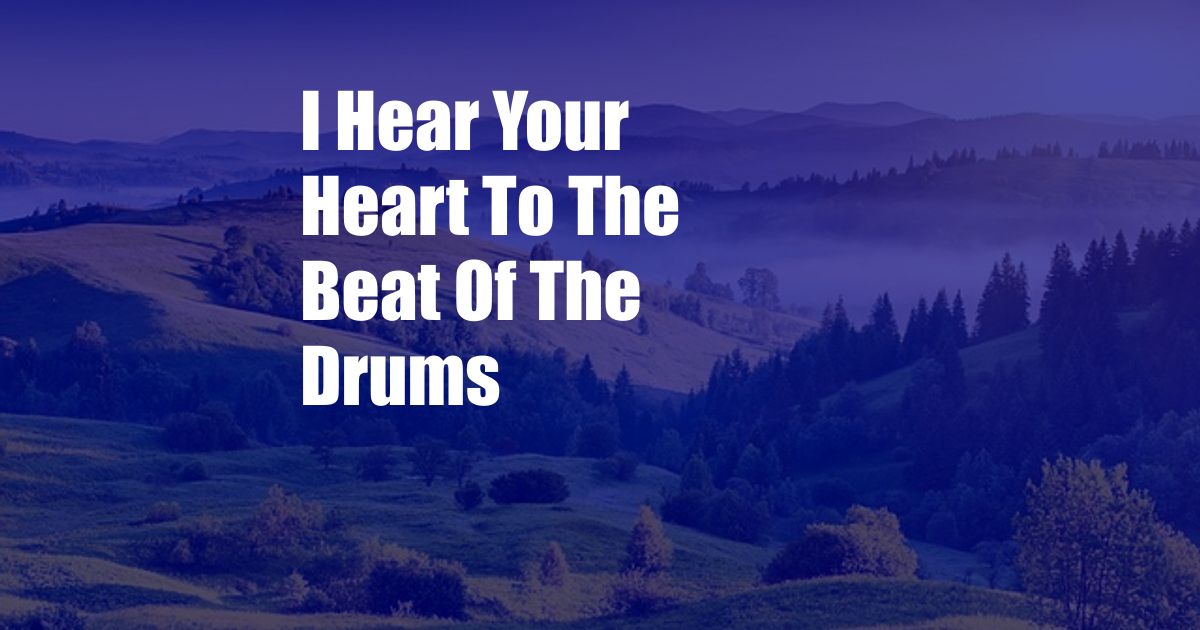
I Hear Your Heart to the Beat of the Drums
I remember it like it was yesterday. I was seven years old, sitting in the backseat of my dad’s car. We were driving home from a long day at the beach, and the sun was setting, casting a warm glow over the city. I was tired, but I was also excited – I had just heard my first live concert, and I couldn’t wait to tell my friends all about it.
As we drove, I looked out the window and saw a group of people gathered in a park. They were all dancing and singing, and there was a band playing on a stage. I asked my dad to stop the car, and we got out and walked over to watch. The band was playing a fast, upbeat song, and the crowd was going wild. I had never seen anything like it before. I was mesmerized by the music, and I couldn’t help but start dancing along.
What is Rhythm?
Rhythm is one of the most important elements of music. It is the pattern of beats and accents that gives music its shape and movement. Rhythm can be created by drums, percussion instruments, or even by the human voice. It can be fast or slow, simple or complex. But no matter what form it takes, rhythm is essential for creating music that is both enjoyable and memorable.
There are many different types of rhythms, but they all share a few common characteristics. First, rhythm is based on a regular beat. This beat can be fast or slow, but it must be consistent. Second, rhythm is created by the alternation of strong and weak beats. Strong beats are accented, while weak beats are not. This alternation of strong and weak beats creates a sense of movement and excitement.
The Importance of Rhythm
Rhythm is important for several reasons. First, it helps to create a sense of order and structure in music. Without rhythm, music would be chaotic and unorganized. Second, rhythm can be used to create a variety of moods and emotions. A fast, upbeat rhythm can create a sense of excitement and energy, while a slow, relaxed rhythm can create a sense of calm and serenity. Third, rhythm can help to improve our physical and mental health. Studies have shown that listening to music with a strong rhythm can help to reduce stress, improve mood, and boost energy levels.
How to Create Rhythm
There are many different ways to create rhythm in music. One of the most common ways is to use drums. Drums are percussion instruments that produce sound when they are struck. Drums can be played in a variety of ways to create different rhythms. For example, a drummer can play a simple beat on a snare drum, or they can create a more complex rhythm by playing a combination of different drums.
Another way to create rhythm is to use percussion instruments. Percussion instruments are instruments that produce sound when they are struck, shaken, or scraped. Some common percussion instruments include tambourines, claves, and maracas. Percussion instruments can be used to create a variety of rhythms, from simple beats to complex patterns.
Finally, rhythm can also be created by the human voice. Singers can use their voices to create rhythms by varying the pitch, volume, and duration of their notes. This technique is called vocal percussion, and it can be used to create a variety of rhythms, from simple beats to complex patterns.
Tips for Creating Rhythm
Here are a few tips for creating rhythm in music:
- Start with a simple beat. Once you have a basic beat, you can start to add variations and embellishments.
- Use a variety of instruments to create rhythm. This will help to create a more interesting and dynamic sound.
- Don’t be afraid to experiment. There are no rules when it comes to creating rhythm. The most important thing is to have fun and create something that you enjoy.
Expert Advice
Here is some expert advice on creating rhythm in music:
“Rhythm is the heartbeat of music. It is what gives music its pulse and its groove. Without rhythm, music would be flat and lifeless.”
– Quincy Jones, music producer and composer
“The most important thing about rhythm is that it must be felt. It must move you. If you can’t feel the rhythm, then you’re not playing it right.”
– Dave Grohl, drummer and singer of the Foo Fighters
FAQ
Here are some frequently asked questions about rhythm:
- What is the difference between rhythm and beat?
- Rhythm is the pattern of beats and accents that gives music its shape and movement. Beat is the regular, underlying pulse of music.
- How can I improve my sense of rhythm?
- There are many ways to improve your sense of rhythm. One way is to listen to music with a strong rhythm and try to tap your foot or clap your hands along to the beat. You can also try playing a simple drum beat on a drum or percussion instrument.
- What are some tips for creating a good rhythm?
- Start with a simple beat and gradually add variations and embellishments. Use a variety of instruments to create rhythm and don’t be afraid to experiment.
Conclusion
Rhythm is an essential element of music. It is what gives music its shape, movement, and groove. Rhythm can be created by drums, percussion instruments, or even by the human voice. It can be fast or slow, simple or complex. But no matter what form it takes, rhythm is essential for creating music that is both enjoyable and memorable.
Do you want to learn more about rhythm? If so, there are many resources available online and in libraries. You can also find many rhythm exercises and tutorials online.